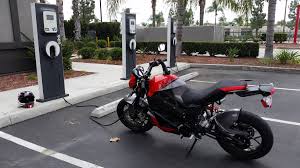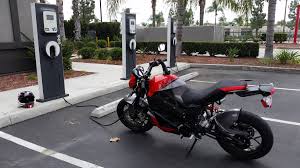Pros and Cons of the Electric Motorcycle
Love them or loathe them, electric vehicles are here to stay. Electric cars are already highly practical: Tesla’s Model S can go over 300 miles on a charge, and even the subcompact Chevy Bolt EV hatchback is supposedly able to go 238 miles. But those are cars, and the Tesla’s battery weighs 1200 pounds, the Bolt’s 960. Not so practical for a motorcycle, where the whole vehicle needs to weigh about half that.
Motorcycle.com’s 2018 Electric Motorcycle Buyer’s Guide
What’s really needed to make the electric motorcycle really take off, of course, is new battery technology that allows those electricity-storage containers to get lighter and smaller. Rest assured, there are thousands of brilliant minds working on that as we speak. I wouldn’t bet against them, but who knows how long the magnesium-ion battery, or whatever it winds up being, will take? For now, these are the benefits and drawbacks of the electric motorcycle as she stands in the year of our Lord 2018.
Discuss this story more at our Electric Motorcycle Forum
PRO
They’re Electric!
It costs around 2 bucks to fill your motorcycle up with electricity that will propel it 100 miles; it costs $8.75 to go that far on your typical Internal Combustion Engine (ICE) motorcycle with gas around $3.50 per gallon at 40 mpg. If you commute or just ride a lot, that difference will add up fast. You also save time by never having to stop for gas. Oil? Strictly for salads.
Will you have to replace your battery? Probably not. Zero warranties its batteries for five years, but states: A typical Zero S or Zero DS can travel over 200,000 miles with the batteries retaining 80% of their original maximum capacity.
Only long-distance travelling motorcycles tend to see that kind of mileage – a mission electric bikes aren’t quite ready to take on.
Low maintenance
No battery to maintain, no clutch, no oil to change, no valves to adjust, no throttle bodies to sync, no air filter to replace… you’ll need fresh tires now and then, brake pads and that’s about it.
Instant torque
Most affordable electrics won’t go much faster than about 90 mph, but lots of them have silly amounts of torque, and their acceleration from a standing start can be just as stimulating, if not more, than most ICE bikes. The Zero DSR we just tested claims 116 pound-feet of torque; most of that’s available as soon as you twist the throttle, which can no longer be referred to as “loud handle.”
For those not restrained by mundane financial considerations, bikes like the $35k Italian exotic Energica Evo come with all the performance most of us could ever want, including an electronically limited 150-mph top end. Wait, scratch that! The Evo’s price is down to $24,900 for 2018!
Silent running
Maybe not so good if you think loud pipes save lives, but after you get used to the absence of noise, it really is nice to listen to nothing but the wind whistling past (you still need earplugs though). If you’re on a dirt road or trail out in the boonies, you’ll even sneak up on unsuspecting wildlife – or neighborhood cats, most of which really enjoy being chased no matter what their owners say.
Modern ICE bikes are remarkably quiet at 80 dB, but if you’re on anything older or with a modified exhaust, your neighbors will probably chip in to help you replace it with an electric. Some owners of bikes with open pipes may even be able to crowdsource funds for an electric bike.
Now that things like the Alta are here, I’m waiting for the first urban MX parks to open, so those of us who enjoy the occasional roost don’t have to drive two hours to do it. How can the neighbors complain when there’s no noise and no fuel being burned? They’ll still find a way, but getting urban youths on small electric bikes could be just the thing to rejuvenate the whole motorcycle industry.
Easy to ride
Without the need to learn how to shift gears, which scares off quite a few wannabe riders, electrics are as easy to ride as a scooter, which is to say no skills required beyond the ability to ride a bicycle: Twist this to go, squeeze this and press that to stop. Rider training will always be important, but the first hurdle is already overcome with electric bikes.
Government subsidies
In addition to the Feds, lots of states encourage you to go green with all kinds of tax incentives.
CON
Initial cost
Electric bikes are still not far past being a cottage industry, and that lack of scale means they can’t compete with ICE bikes pricewise. Zero’s entry-level S model starts at $10,995 – but again, there are tax incentives and rebates, and again, you’re not putting $15 of gas in the fuel tank every week or every few days. You could also spend $24.9k for an Energica Evo, which is billed as the world’s first electric superbike, with performance to back up the claim. That’s about $2.5k less than a Ducati Panigale V4 S, though, so…
Range anxiety
Just like staring at a blinking fuel light on your ICE bike with 20 miles to the next gas station, it can be unsettling to watch your charge meter go from 20% to 10% to 2% when you’ve still got a few miles to cover. Really that’s just a matter of planning, though. Many electric riders use their bikes for commuting a known, fixed distance, and range is never a concern (unless you get halfway to work and look down to realize you forgot to plug in last night). And if you’re mostly zipping around town less than 80 or so miles a day, like the vast majority of motorcyclists, electrics are fantastic.
As electric cars become more common, charging stations are springing up like proverbial wildflowers, and are easy to find with a phone app or two.
Charging time
You can get a quick top-up charge to get where you need to be most of the time in half an hour, but a full charge is going to take from two to ten hours, depending. Charge rate remains a problem for current lithium ion batteries. Along with greater storage capacity and therefore greater range, new battery technology will also offer much faster recharging times. We’re not there yet. Some say we won’t be anytime soon. Choose your pundit.
Weight
The aforementioned Evo weighs about 570 pounds to the Panigale’s 386-pound dry weight. There’s just no getting around the fact that batteries are heavy, and weight is a major component of how a motorcycle handles and feels.
On the other hand, though it offers far less performance than the Evo, Zero says its base model Zero S weighs just 313 pounds, and the DSR we just tested weighs 419. Not bad at all. Zippy, even.
No more mechanicing in the garage
If you liked to play with your tools while listening to your Zamfir CDs and tuning out the world, electric motorcycles will give you less opportunity to do that, but then they’re great for running to the Harbor Freight yet again while you work on the old Triumph. For the vast majority of people interested in electrics, the lack of maintenance is a selling point, not a detractor.
Fewer funny Youtube crashes
With no need to learn to use a clutch, there will be far fewer people launching themselves through fences and parking lots. We’ll miss that.
More by John Burns









































Comments
Join the conversation
Torque shmork. The manner in which e-bikes advertise torque is at the motor shaft. That torque gets multiplied by ratio ONE time to the rear wheel.
ICE bike measures torque at the crankshaft, which get's multiplied 3x or more times before reaching the rear wheel. Anyone dyno'd torque at the rear wheel on their gas powered bike in 1st or 2nd gear lately?
Cost! e-bikes are WAY more expensive to purchase. Tax incentives? That just means those who don't want e-bikes pay for yours.
Time to recharge is ridiculous. 5 minutes for another 200+ miles on a gas bike? Easy peasy.
There's just so much about e-bikes that's so behind ice bikes. The controls, heat management, outright power, build quality for equivalent purchase cost, display interface, parts infrastructures, aftermarket customization.
No more rev-bombing under bridges. That's the biggest downfall. :-P
First of all, a recent study was done examining the replacement of fuel burning cars estimated to be sold between now and 2030, and replaced that number with electrics. The *total* amount of pollution generated by the increased output of electrical generation plants to handle that many vehicles was *more* than the amount of tailpipe emissions generated by ICE's.
Second, the "Cons" section in this article was nothing of the sort. All but one of the Cons (weight) contained ancillary comments that attempted to downplay the chosen "con."
Electrics have been with us for more than a century and at one time (the 19-teens) accounted for 1/3 of all vehicles sold in the US. The problem then was the same as now; the technology just couldn't keep pace.